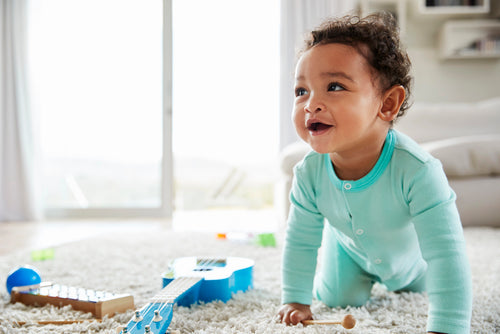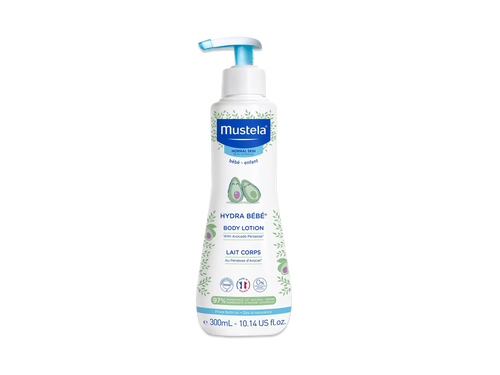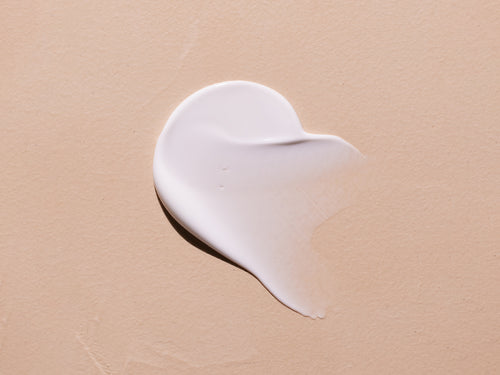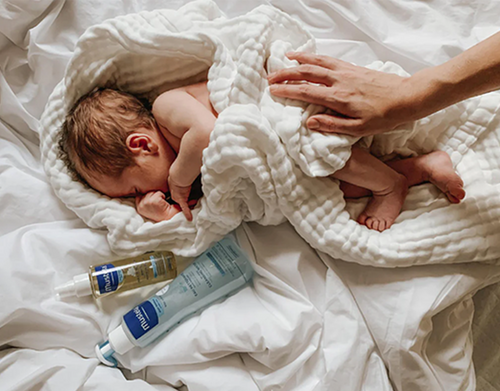Welcome to the world of curly baby hair! While you love your little one’s adorable locks, you may feel overwhelmed by how to properly care for and style them.
But don’t worry; we’ve got you covered. In this guide, we’ll discuss everything you need to know about curly baby hair — from understanding its unique characteristics to learning how to maintain and style it.
Understanding Curly Baby Hair

Before we dive into the care and styling tips, it’s essential to understand what makes curly baby hair different from straight hair. At the most basic level, this hair type refers to a baby’s natural hair texture with spiral or wavy curls.
However, curly hair is a broad category, and each baby’s curls can vary in pattern, texture, thickness, and density. As a result, caring for your little one’s hair requires a more personalized approach.
That’s where the Walker Scale comes into play.
The Walker Scale
This scale classifies hair into four main categories (Type 1 to Type 4) based on its curl pattern. Within each category, further subcategories consider the width of each curl.
Knowing your baby’s hair type can help you choose the right products, techniques, and styles for their unique curls.
Here are the four main types:
- Type 1: Straight
- Type 2: Wavy
- Type 3: Curly
- Type 4: Kinky or Coily
The scale further breaks down wavy and curly hair types as follows:
Type 2
Type 2 hair has an “S” shape wave. Wavy hair requires more effort to get a definite shape than the other curls.
- Type 2A: Very fine hair with S-shaped waves toward the ends
- Type 2B: Thicker S-shaped waves that start about halfway down the hair shaft
- Type 2C: Thick S-shaped waves from the root down
Type 3
Type 3 hair has corkscrew or ringlet curls. The curls range from bouncy spirals to tight corkscrews.
- Type 3A: Large, loose curls
- Type 3B: Smaller, more defined curls
- Type 3C: Tight, corkscrew curls
Type 4
Type 4 hair has a tight curl pattern and can range from fine and soft to wiry and coarse.
- Type 4A: Small, dense S-shaped coils
- Type 4B: Tightly packed Z-shaped coils
- Type 4C: Tightly coiled hair with Z-shaped coils and no discernible curl pattern
Curly Hair Characteristics

Now that you know more about the different types of curly hair, let’s take a closer look at some common characteristics.
- Dryness: Curly hair tends to be drier than straight hair due to its shape and texture. It’s harder for your baby’s natural oils to travel down the curls, making their hair more prone to frizz and breakage.
- Porosity: The porosity level in curly hair can vary, but it tends to be more porous than straight hair. This means it can absorb moisture easily but also lose it quickly.
- Easily tangled: The curls can easily tangle with themselves or other hairs, making it important to gently detangle regularly.
- Fragile: Curly hair is fragile, so handle with care!
Importance Of Using The Correct Products
Since curly hair has different characteristics than straight hair, you’ll want to choose products specifically designed for this type.
Unfortunately, finding clean products you feel comfortable using on a baby hasn’t always been easy. Historically, many parents chose to use adult hair care products on their babies and children because that’s all that was available.
Now, baby shampoo is a great choice to cleanse and nourish your baby’s curly hair gently!
But a safe and effective shampoo isn’t the only product you need when caring for your baby’s hair. Below are some other items to keep on hand.
Wide-Tooth Comb
Brushing curly hair can cause damage or hair loss, so it’s best to carefully comb through knots and tangles with a wide-tooth comb.
Detangling Spray
Mustela’s Detangling & Nourishing Cream Shampoo helps detangle and nourish curls, but between washings, you may want to use a detangling spray to avoid hair drama.
Microfiber Towel Or T-Shirt
Friction from traditional cotton towels can cause curly hair to frizz. Instead, use a microfiber towel or an old t-shirt to gently squeeze out excess water.
A Spray Bottle Of Water
Use a spray bottle of plain water to quickly add moisture to your little one’s locks if you’re trying to style it or refresh it throughout the day.
Soft Hair Ties
Those old-school rubber bands with metal pieces can damage or break curly hair. Opt for soft, fabric hair ties to keep your baby’s curls in place without harming them.
Caring For Your Baby’s Curls

Choosing the right products is just one aspect of caring for curly hair. Let’s look at some other vital steps.
Washing Curly Baby Hair
When washing your baby’s curls, less is more. Avoid washing their hair daily, as doing so can strip the natural oils and moisture from their curls. Instead, choose a gentle shampoo and aim to wash their hair two or three times a week.
Once your baby is in the tub, wet their hair and apply a dollop of shampoo. Massage it gently to lather, and then rinse it out.
Here are some tips to help make this process simple:
- Focus on your baby’s scalp. Scrubbing the hair lengths can make them brittle and prone to breakage.
- Divide their hair into four or six parts and massage the shampoo into each area of the scalp with your fingertips.
- Rinse carefully with clean water. Aim to get all of the foam off their scalp.
- After their bath, use a t-shirt or microfiber towel to remove as much water as possible. Then, wrap it around your baby’s hair and allow it to sit for a few minutes to absorb more water.
Dealing With Tangles And Knots
Tangles and knots are common in curly hair, but they can be especially challenging for babies and toddlers, who don’t yet understand how to sit still during hair care.
Washing your little one’s hair with Mustela’s Detangling & Nourishing Cream Shampoo is the first step in taming tangles. After that’s done, knots can more easily be removed using a wide-tooth comb.
Start at the ends when you comb, and carefully work your way to the scalp. Going the other way can make tangles worse.
Tips For Styling Your Baby’s Curly Hair

Once your baby’s hair is clean and detangled, it’s ready for styling. Here are some simple styling tips for curly hair.
Keep It Trimmed
While you may not be ready to give your little one their first haircut, keeping their curly locks trimmed can help prevent split ends and keep their hair looking healthy.
Since there is a “right” way to cut curly hair, it’s essential to find a stylist who specializes in cutting and styling curls.
Avoid Heat Styling Tools
Can you imagine using a blow dryer, straightener, or other heat-based styling tool on a squirmy baby? No thanks! Not only do you risk burning your little one, but you also risk damaging their delicate curly hair.
Instead, embrace your baby‘s natural curls and avoid heat-styling tools altogether. It’ll save you time and hassle while promoting healthy hair growth.
Consider Protective Styling
Protective styling — such as braids, twists, and buns — can minimize damage and reduce the need for daily styling. When choosing protective styles for your baby, make sure they’re not too tight or heavy. You don’t want your little one to be uncomfortable.
You’ll also want to give their hair a break between styles and mix it up. Otherwise, you may cause damage due to constant tension in the same areas.
Embrace The Curls
Most importantly, embrace your baby’s curls! Curly hair is beautiful and unique, so celebrate your baby’s natural hair and teach them to love and care for it from a young age. It’ll boost their self-esteem and instill important values of self-love and acceptance.
Gently Care For Your Baby’s Curls With Mustela

Caring for curly baby hair can be a challenging but rewarding experience. The simple care and styling tips in this article can help promote healthy hair growth and keep your little one’s hair looking adorable.












